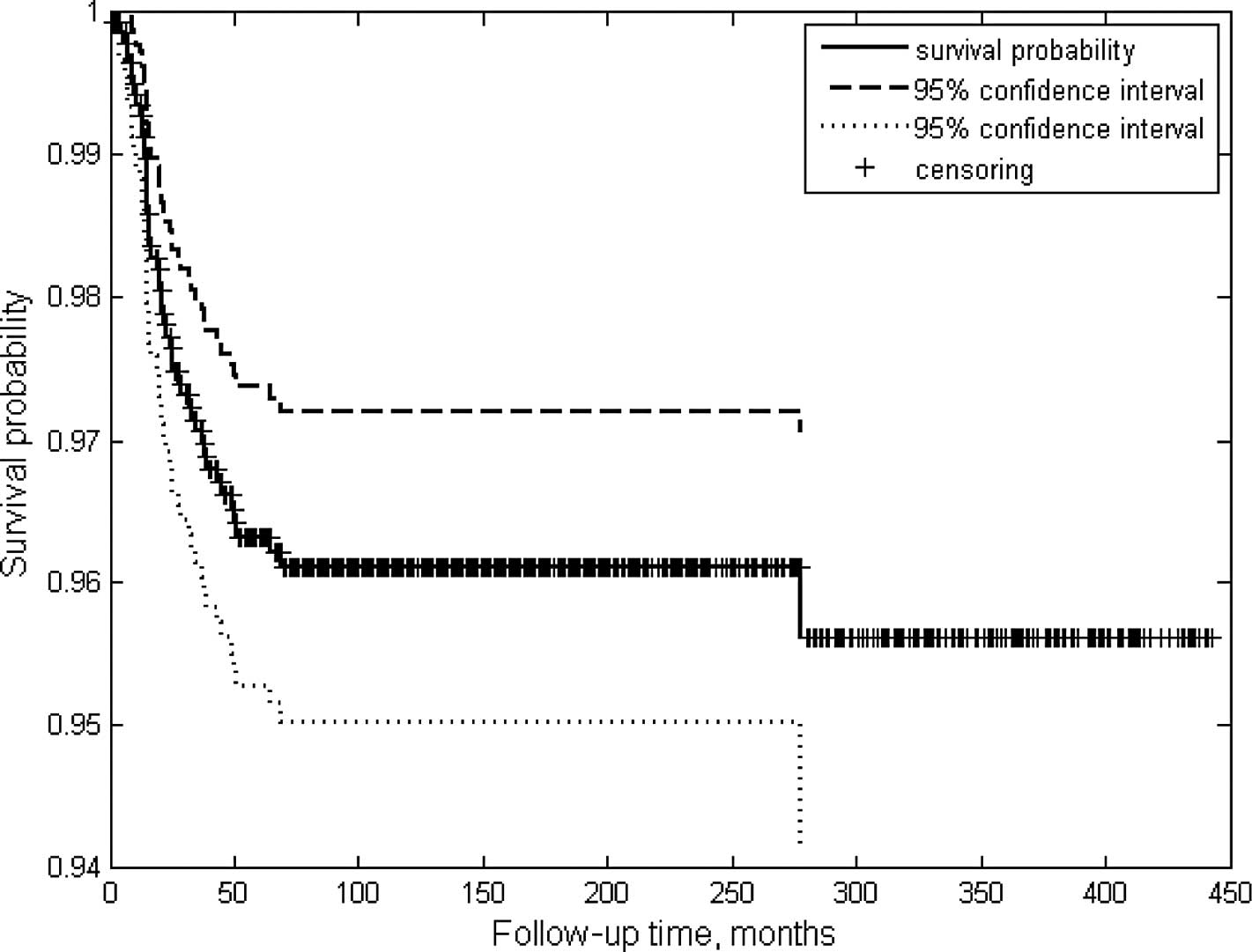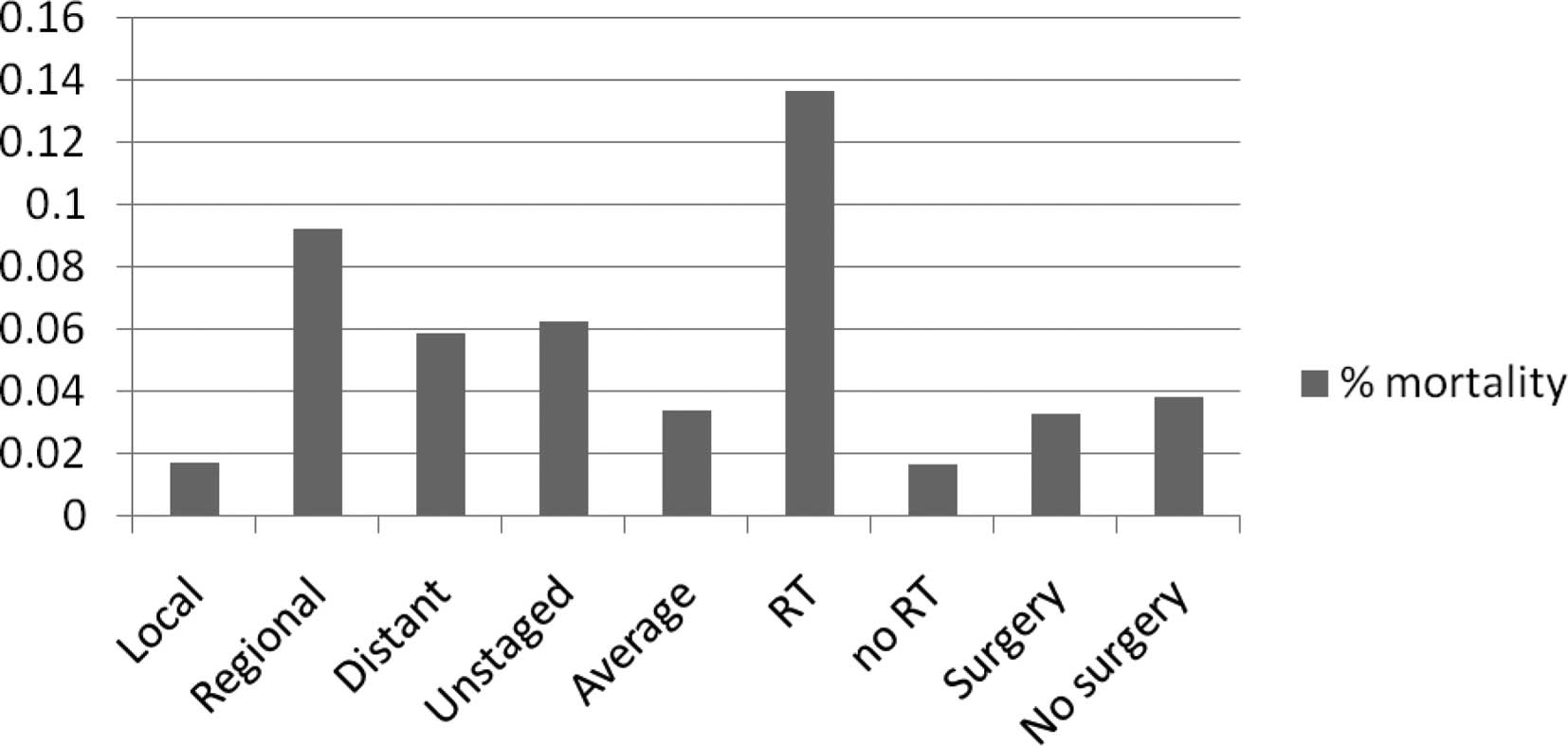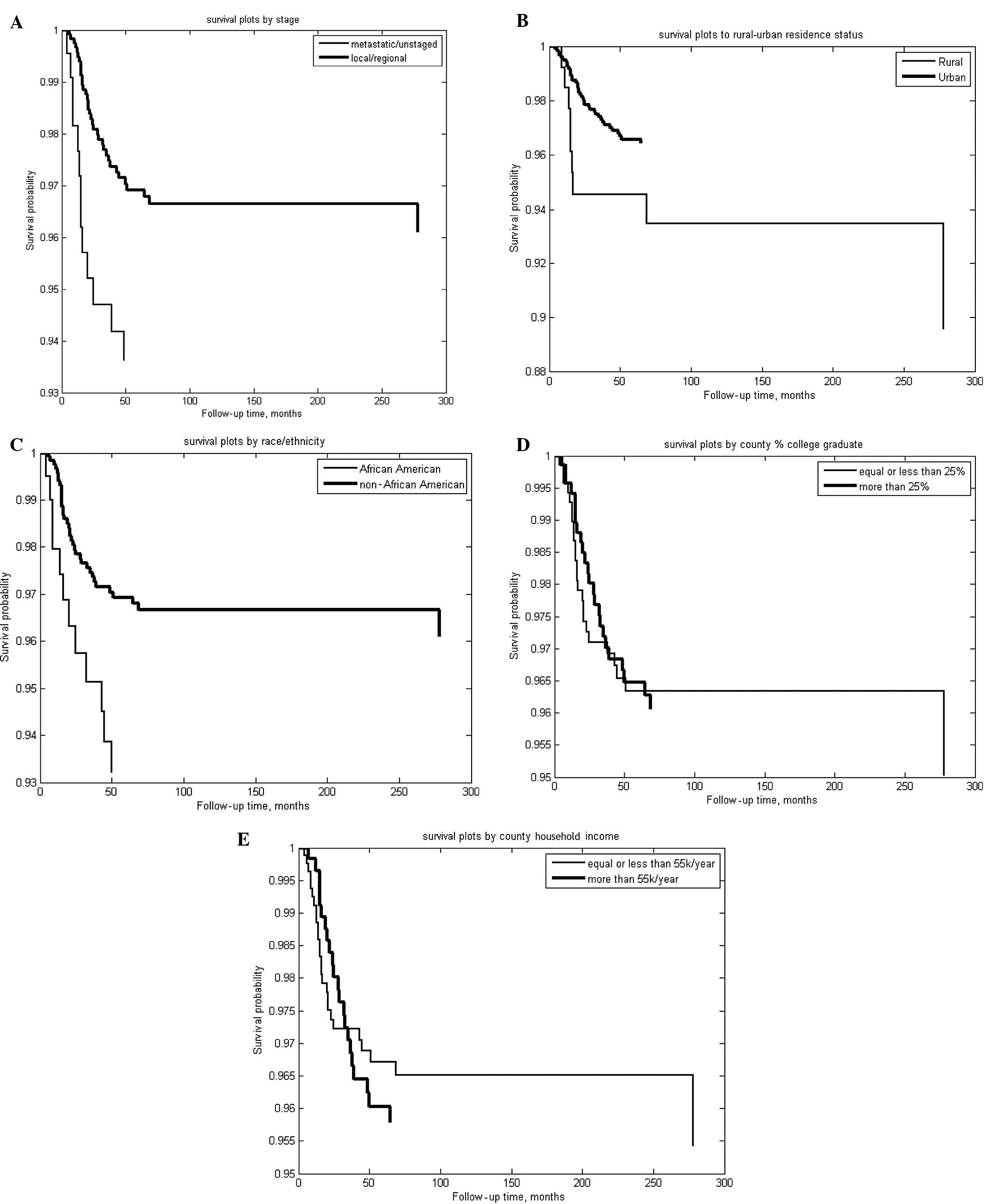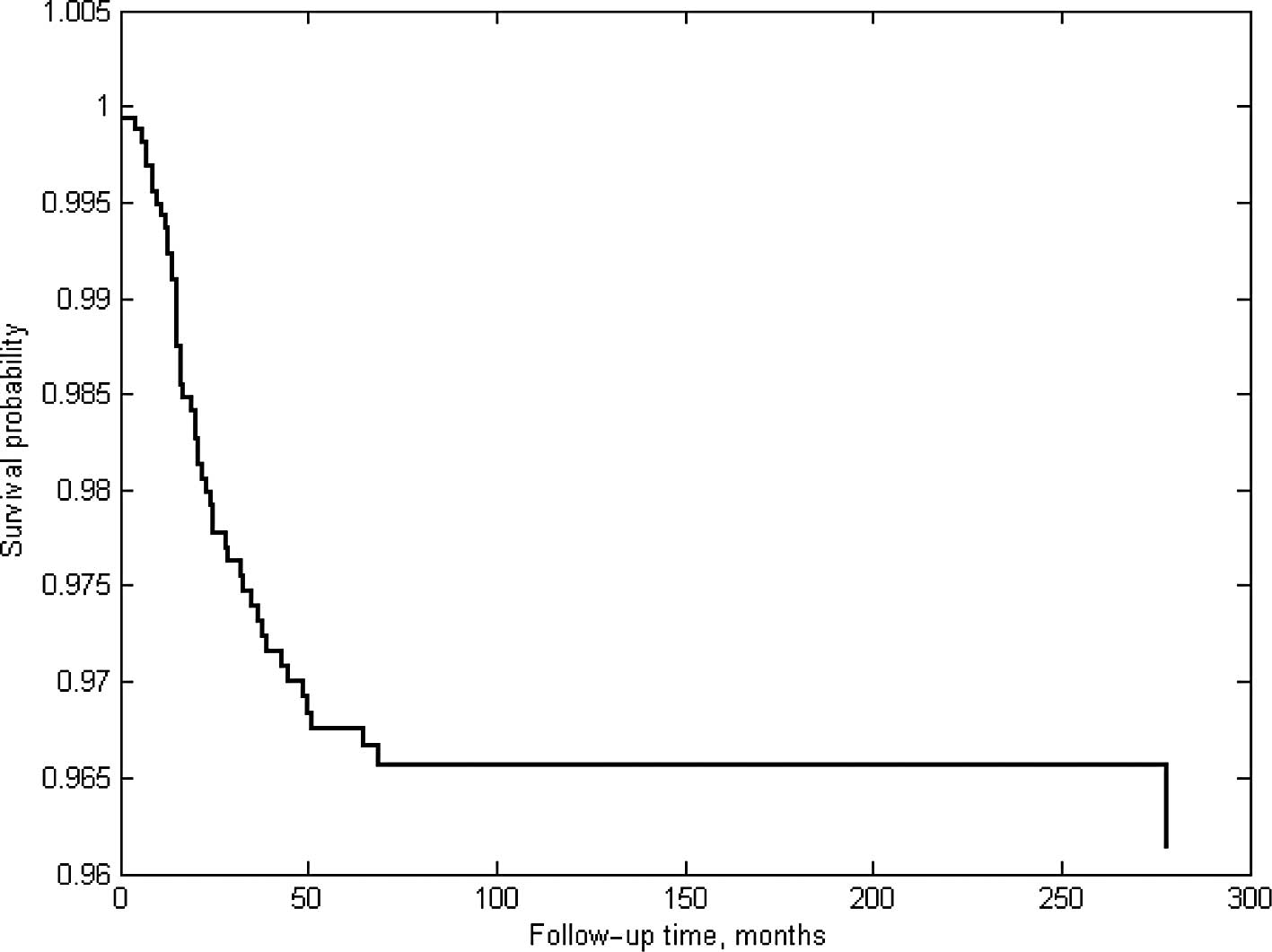Impact of socioeconomic disparities on cause-specific survival of retinoblastoma
- Authors:
- Published online on: March 1, 2013 https://doi.org/10.3892/mco.2013.83
- Pages: 535-540
Abstract
Introduction
Retinoblastoma (RB) is a rare disease of infancy and early childhood (1). It is rarely encountered in adults. The majority of RB patients exhibit excellent survival outcomes (2,3). At present, the standard staging system that is internationally used is the International Retinoblastoma Staging System (4). Staging is an important factor affecting treatment selection and outcome (5). Previous studies demonstrated that African-American descent adversely affected the outcome of RB, a finding that may be due to limited access to treatment (6,7). Further investigations are required to identify the socioeconomic barriers to optimal RB outcomes.
The Surveillance, Epidemiology and End Results (SEER; http://seer.cancer.gov/) program is a public-use cancer registry of the USA National Cancer Institute. SEER is widely used as a source of benchmark data for studying RB outcomes in the USA as well as in other countries (1,3,8–11). In addition to the biological and treatment factors, this database also provides a large number of county-level socioeconomic factors. This study was part of a larger study that aimed to identify barriers to optimal cancer treatment outcomes, which may be discernable only from information obtained from a national database.
Materials and methods
SEER is a public-use database that may be used for analysis with no requirement for internal review board approval. SEER Clinical Outcome Prediction Expert (SCOPE) (12) was used to mine SEER data and construct accurate and efficient prediction models (13,14). Data were obtained from the SEER 18 database, using the filter ‘Site and Morphology’. ICCC site recode ICD-O-3 = ‘V Retinoblastoma’. The SEER*Stat statistical software (http://seer.cancer.gov/seerstat/) was used for case listing. Kaplan-Meier analysis was used to assess the time to RB-specific mortality (coded as Eye and Orbit mortality in SEER) data. The two-sample Kolmogorov-Smirnov test was used to assess the significance of the difference between two survival curves. The Cox proportional hazards model was used for multivariate analysis. For univariate and multivariate analyses, coding was as follows: i) SEER stage: 0, local/regional; 1, metastatic/unstaged; ii) county-level rural vs. urban residence status: 0, urban residence; 1, rural residence; iii) race/ethnicity: 0, non-African American; 1, African American; iv) county-level percentage of college graduates: 0, >25%; 1, ≤25%; v) county-level household income: 0, >55,000 USD/year; 1, ≤55,000 USD/year. All statistics and programming were performed by Matlab (www.mathworks.com). The areas under the receiver operating characteristic (ROC) curves were computed for predictors. In addition, binary fusion and optimization were used to streamline the ROC risk stratification by combining risk strata when possible. Similar strata were fused to create more efficient models if the resultant ROC performance did not degrade (13,14).
Results
A total of 1,456 patients were included in this study (Table I). The Kaplan-Meier survival curve exhibited an excellent long-term cause-specific survival rate of >90% (Fig. 1). The mean follow-up time (SD) was 128.75 (113.74) months and the mean age (SD) was 1.4 (2.6) years. There were only 5 adult RB patients listed by the SEER 18 database, a number representing ∼28% of the USA cases reported between 1973 and 2009. The majority of the patients had been staged and SEER stage was the most significant predictive factor, with an ROC area of 0.64 (0.01) (Table I). The ROC area of this model was computed from 5 samples that were randomly selected from the case pool. Each sample represented 50% of the total number of cases. As shown in Fig. 2, the risk did not progress from lower (local stage)- to higher (distant stage)-risk groups. Furthermore, ROC analysis revealed that regional and distant groups may be combined in terms of predicting the cause-specific survival of RB patients. A significant number of unstaged patients were identified, accounting for 7.5% of the patient population (Table I and Fig. 2). Unstaged patients exhibited a high risk of mortality, comparable to that of metastatic RB patients (Fig. 2). The SEER staging model was initially created as a 4-tiered model (Table I). Radiotherapy (RT) was used in ∼10% of patients and was predictive of worse outcome (RB-specific mortality risk, 13.7%). The use of RT as an eye-preservation treatment has declined over the years (Fig. 3), possibly due to the secondary cancers that have been attributed to RT in RT-treated patients (15).
Table IUnivariate risk models including sociodemographic, tumor and treatment risk factors for disparity in RB treatment outcome. |
As regards the pretreatment factors, Table II shows that gender, county-level household income and county-level percentage of college graduates did not divide RB patients into subgroups with distinct risk factors of cause-specific RB mortality. The mean follow-up time was ∼10 years (Table I) and the overall risk of cause-specific mortality was ∼3% (Fig. 2). However, groups not optimal in terms of race and rural-urban continuum factors have doubled this risk to ∼6%. Thus, race and rural-urban continuums were expected to exhibit large ROC areas. However, their ROC areas were only moderately larger than the expected 0.5 for a random variable (Table I). When analyzed by time to cause-specific mortality, however, Fig. 3 and Table III show that SEER stage, race and rural-urban residence status were significant univariate predictors, unlike county-level household income or percentage of college graduates. Table III shows that the effects of race and rural-urban residence on RB outcome, as measured by Cox coefficients, are comparable to the effect of SEER stage. The Cox proportional hazard fit from the related Cox analysis (Table III) is shown in Fig. 4.
Table IIRisk of RB-specific mortality (%) associated with gender, age and various socioeconomic models. |
Discussion
RB treatment exhibits success rates of >90% (Fig. 1). Previous studies demonstrated that socioeconomic factors may affect the outcome of RB patients (6,7) and that relocation of individuals from low-income to higher-income neighborhoods lowered the rates of obesity and diabetes over a 10–15-year follow-up period (16,17). The aim of this study was to identify socioeconomic factors affecting the cause-specific survival of RB, in order to generate testable hypotheses for future trials of removing socioeconomic barriers to optimal RB outcomes. Therefore, this study investigated numerous possible explanatory factors (Table I).
The use of RT has declined over the years. This is likely due to severe long-term side effects. However, the long-term outcomes following treatment with aggressive chemotherapy have not been well characterized (2). Considering the improvement in proton therapy techniques, modern image guidance coupled with proton beam RT may need to be re-evaluated regarding its utility in the treatment of RB (18–20).
The International Retinoblastoma Staging System (4) serves as an important guide for the treatment selection and outcome of RB patients (5). However, this study used SEER staging, which has been consistent over the years, in order to analyze follow-up data in their entirety. SEER staging was identified as the most significant pretreatment predictive factor (Table I). After binary fusion, the optimized staging was reduced to a 3-tiered classification (Fig. 2 and Table I). Such efficient models may aid in reducing the number of patients required for clinical trials, since it has fewer risk groups to balance. Whether the SEER staging model is more accurate compared to the alternative models (1,3) may be elucidated by further investigations. As a point of reference, we estimated that the ROC area of a commonly used prognostic model for prostate cancer using PSA, Gleason Score and prostate T-stage, had a ROC area of 0.75 (13,14,21).
Using ROC area as a metric and a binary fusion algorithm, the 4-tiered SEER staging model was simplified into a 3-tiered model. The ROC area of this model was comparable to the original risk model. Thus, the model is simplified by 25% without an accuracy penalty. This may be of significance, considering that 25% less trial participants may be required to balance the risk profiles of the test and control arms. This is particularly relevant since several clinical trials are available for RB and other childhood cancers (6,7). Unstaged patients are associated with a high risk of mortality, comparable to that of metastatic RB patients (Fig. 2), possibly due to the fact that without accurate staging, it would be difficult to select the optimal treatment option. Staged patients fared better compared to the overall cohort (Table II and Fig. 3A).
SEER data are particularly useful in ascertaining treatment individualization and have been used by previous studies (7,9–11). In order to demonstrate the independent prognostic values of socioeconomic factors, we performed univariate and multivariate analyses of socioeconomic factors in combination with the most significant biological factor (SEER stage). Residing in areas with populations of <25,000 was associated with high risk of RB-specific mortality, as was African American descent (Table II, Fig. 3B–C and Table III); however, county-level household income and percentage of college graduates were not associated with a higher risk of mortality (Fig. 3D–E and Table III).
In conclusion, this study identified the most prognostic staging models according to pretreatment factors for RB cancer patients. Socioeconomic barriers identified included race and rural-urban residence. African American descent and rural residence led to a 3% decrease (Table II) in RB cause-specific survival. Eliminating barriers to optimal treatment may reduce outcome disparity in RB patients.
References
|
Broaddus E, Topham A and Singh AD: Incidence of retinoblastoma in the USA: 1975–2004. Br J Ophthalmol. 93:21–23. 2009. | |
|
Abramson DH, Marr BP, Brodie SE, et al: Ophthalmic artery chemosurgery for less advanced intraocular retinoblastoma: five year review. PLoS One. 7:e341202012.PubMed/NCBI | |
|
Broaddus E, Topham A and Singh AD: Survival with retinoblastoma in the USA: 1975–2004. Br J Ophthalmol. 93:24–27. 2009. | |
|
Sastre X, Chantada GL, Doz F, et al: Proceedings of the consensus meetings from the International Retinoblastoma Staging Working Group on the pathology guidelines for the examination of enucleated eyes and evaluation of prognostic risk factors in retinoblastoma. Arch Pathol Lab Med. 133:1199–1202. 2009. | |
|
Schvartzman E, Chantada G, Fandino A, et al: Results of a stage-based protocol for the treatment of retinoblastoma. J Clin Oncol. 14:1532–1536. 1996.PubMed/NCBI | |
|
Pui CH, Pei D, Pappo AS, et al: Treatment outcomes in black and white children with cancer: results from the SEER database and St Jude Children’s Research Hospital, 1992 through 2007. J Clin Oncol. 30:2005–2012. 2012.PubMed/NCBI | |
|
Liu L, Krailo M, Reaman GH and Bernstein L: Childhood cancer patients’ access to cooperative group cancer programs: a population-based study. Cancer. 97:1339–1345. 2003. | |
|
Kleinerman RA, Tucker MA, Abramson DH, et al: Risk of soft tissue sarcomas by individual subtype in survivors of hereditary retinoblastoma. J Natl Cancer Inst. 99:24–31. 2007. View Article : Google Scholar : PubMed/NCBI | |
|
Lanier AP, Holck P, Ehrsam Day G and Key C: Childhood cancer among Alaska natives. Pediatrics. 112:e3962003. View Article : Google Scholar : PubMed/NCBI | |
|
Gatta G, Capocaccia R, Coleman MP, Ries LA and Berrino F: Childhood cancer survival in Europe and the United States. Cancer. 95:1767–1772. 2002. View Article : Google Scholar : PubMed/NCBI | |
|
Breslow NE and Langholz B: Childhood cancer incidence: geographical and temporal variations. Int J Cancer. 32:703–716. 1983. View Article : Google Scholar : PubMed/NCBI | |
|
Cheung R: Poor treatment outcome of neuroblastoma and other peripheral nerve cell tumors may be related to under usage of radiotherapy and socio-economic disparity: a US SEER data analysis. Asian Pac J Cancer Prev. 13:4587–4591. 2012. View Article : Google Scholar | |
|
Cheung R, Altschuler MD, D’Amico AV, et al: ROC optimization may improve risk stratification of prostate cancer patients. Urology. 57:286–290. 2001. View Article : Google Scholar : PubMed/NCBI | |
|
Cheung R, Altschuler MD, D’Amico AV, et al: Using the receiver operating characteristic curve to select pretreatment and pathologic predictors for early and late postprostatectomy PSA failure. Urology. 58:400–405. 2001. View Article : Google Scholar : PubMed/NCBI | |
|
Vasudevan V, Cheung MC, Yang R, et al: Pediatric solid tumors and second malignancies: characteristics and survival outcomes. J Surg Res. 160:184–189. 2010. View Article : Google Scholar : PubMed/NCBI | |
|
Ludwig J, Sanbonmatsu L, Gennetian L, et al: Neighborhoods, obesity, and diabetes - a randomized social experiment. N Engl J Med. 365:1509–1519. 2011. View Article : Google Scholar : PubMed/NCBI | |
|
Ludwig J, Duncan GJ, Gennetian LA, et al: Neighborhood effects on the long-term well-being of low-income adults. Science. 337:1505–1510. 2012. View Article : Google Scholar : PubMed/NCBI | |
|
Chang JW, Yu YS, Kim JY, et al: The clinical outcomes of proton beam radiation therapy for retinoblastomas that were resistant to chemotherapy and focal treatment. Korean J Ophthalmol. 25:387–393. 2011. View Article : Google Scholar : PubMed/NCBI | |
|
Munier FL, Verwey J, Pica A, et al: New developments in external beam radiotherapy for retinoblastoma: from lens to normal tissue-sparing techniques. Clin Experiment Ophthalmol. 36:78–89. 2008. View Article : Google Scholar : PubMed/NCBI | |
|
DeLaney TF: Clinical proton radiation therapy research at the Francis H. Burr Proton Therapy Center. Technol Cancer Res Treat. 6(Suppl 4): 61–66. 2007. View Article : Google Scholar : PubMed/NCBI | |
|
Hanley JA and McNeil BJ: The meaning and use of the area under a receiver operating characteristic (ROC) curve. Radiology. 143:29–36. 1982. View Article : Google Scholar : PubMed/NCBI |













